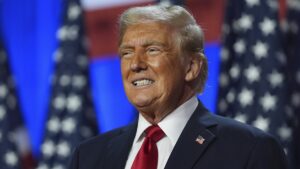
donald trumps
In a groundbreaking move, the United States and China have agreed to pause their tariff war for 90 days. This unexpected truce represents a significant de-escalation in a trade conflict that has rattled the global economy for more than a year. The tariff reductions agreed upon by both parties are seen as a hopeful sign that the two largest economies in the world may be able to put aside their differences and find common ground. But what does this agreement mean for the future of US-China trade relations and the global economy?

The Terms of the 90-Day Truce:
The newly forged deal, announced in a joint statement, outlines substantial reductions in tariffs from both sides. Under the agreement, the United States has agreed to reduce its tariffs on Chinese goods from 145% to 30%. On the other hand, China will lower its tariffs on American goods from 125% to 10%. The 90-day pause in tariffs is expected to provide a reprieve to businesses, manufacturers, and consumers who have been impacted by the long-standing trade war.
The tariff reductions are not just symbolic gestures. They represent significant financial relief for industries that have been reeling under the weight of these punitive tariffs. In the United States, the agricultural and manufacturing sectors have borne the brunt of the tariff war, with farmers and manufacturers suffering from both higher costs and reduced market access. China has similarly been impacted by the trade conflict, with its economy slowing down due to the tariffs imposed by the US.
Economic Relief and Business Impact:
For both countries, the agreement is a much-needed break from the intense economic pressure created by the trade war. US businesses, especially those in manufacturing, agriculture, and technology, have faced increased costs for raw materials, equipment, and parts due to tariffs. China, too, has been hurt by the trade war, with the country’s manufacturing sector facing delays in shipments, higher production costs, and difficulties in accessing markets.
One of the primary objectives of the tariff reductions is to provide immediate economic relief to these sectors. Lower tariffs will result in lower prices for consumers and businesses alike, allowing US manufacturers to access Chinese goods at a reduced cost and vice versa. Additionally, businesses will now be able to engage in trade with fewer restrictions, improving supply chain stability and minimizing disruptions.
The tariff pause also comes at a crucial time for both economies. The United States is currently grappling with concerns about a slowdown in growth, while China has been facing a slowdown in its own economic expansion. This deal provides an opportunity for both nations to reset their trade relations, which is expected to boost investor confidence in both countries.

The Global Economic Implications:
While the US-China trade war has primarily been a bilateral dispute, its effects have reverberated across the global economy. Countries around the world have felt the impact of the tariffs, especially those in Asia, Europe, and emerging markets. As the two largest economies in the world, the US and China have a significant influence on global trade flows, and their economic activities impact the supply chains of companies operating globally.
The 90-day truce is a welcome development for the global economy, particularly for businesses that rely on the trade relationship between the US and China. The reduction in tariffs is expected to stabilize global supply chains, promote cross-border trade, and encourage international investments. Furthermore, the truce will help restore some level of certainty to the global markets, which have been plagued by volatility and unpredictability over the past year due to the tariff dispute.
The impact of the truce on stock markets has already been felt, with global markets reacting positively to the news. Asian and European stock markets surged in the wake of the announcement, and US stock indices also saw gains. The global economy, particularly countries heavily dependent on US-China trade, stands to benefit from this agreement, which could lead to a reduction in trade barriers and open up new avenues for economic collaboration.
Challenges and Remaining Issues:
Despite the positive developments, experts caution that the 90-day tariff pause is just a temporary measure. The US and China still have significant differences to resolve in their trade relations, particularly on issues such as intellectual property, market access, and the protection of domestic industries. The tariff reductions agreed upon in this deal do not address these underlying concerns and will require ongoing negotiations to fully resolve.
The intellectual property issue, in particular, remains a key point of contention between the two countries. The United States has long accused China of engaging in unfair practices related to intellectual property theft and forced technology transfers. While the truce may help to ease some tensions, resolving these deeper issues will require further talks, and it is unclear whether the 90-day pause will be enough to pave the way for more substantial reforms.
Additionally, the truce does not address the long-term structural imbalances in the global economy. The trade war has exposed significant disparities between the two nations in terms of their economic power and trade practices. Although both sides have agreed to this temporary tariff reduction, structural reforms to ensure fair trade practices and market access will require further discussions and may take much longer to implement.
The Path Forward:
The 90-day tariff pause presents an opportunity for both the US and China to engage in more meaningful negotiations and work toward a long-term resolution of their trade issues. However, the world will be watching closely to see whether this truce can lead to a lasting peace in the trade dispute. While the agreement is a step in the right direction, it will not be enough on its own to resolve all the underlying tensions between the two countries.
For the US, this deal could serve as a way to demonstrate a commitment to fair trade and economic cooperation, while China can use the opportunity to restore its economic momentum. However, both nations must remain committed to addressing the structural issues in their trade relationship and work towards a comprehensive agreement that benefits both sides.
As the clock ticks on the 90-day truce, it is important to recognize that the path to a lasting solution will not be easy. Trade experts and policymakers must work together to tackle the root causes of the conflict and create a more equitable trade system that benefits not just the US and China, but the entire global economy.

Conclusion:
The US-China 90-day tariff pause marks a turning point in the trade war, offering a temporary respite for both countries and the global economy. While the agreement represents a significant de-escalation in trade tensions, it is clear that much work remains to be done to address the structural issues that have led to this conflict. This truce may serve as the first step toward a more cooperative trade relationship between the US and China, but the road ahead will require sustained effort, negotiation, and compromise from both sides.
As the two nations continue their discussions, the world will be watching closely to see if this momentary thaw in relations can lead to a more enduring peace and, ultimately, a more balanced and fair global trade system. For now, businesses, consumers, and governments around the world can take solace in the fact that this deal brings some stability and certainty to an uncertain global landscape.





